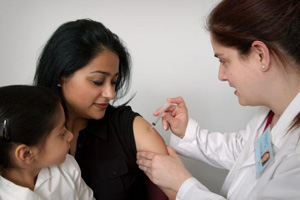RENEWED and reinvigorated public health campaigns are needed to lift influenza vaccination rates with the 2013 flu season in Australia already showing signs of being a serious one, according to a leading influenza specialist.
Responding to two research papers published in the latest edition of the MJA, Dr Alan Hampson, a consultant virologist with Interflu in Melbourne, told MJA InSight the first 3 months of the year had already seen higher than average numbers of influenza cases and that vulnerable groups, particularly pregnant women, should be targeted by public health campaigns.
A self-administered survey of 815 women attending antenatal clinics during the 2011 NSW influenza season found that health care provider recommendation was strongly linked to the uptake of influenza vaccination by pregnant women. (1)
Only 27% of survey respondents reported having the vaccine, largely because less than half received a recommendation from their GP or obstetrician to do so, the study authors wrote.
“Information for pregnant women and providers, coupled with easily accessible vaccine, have the potential to substantially increase maternal influenza vaccination coverage”, they wrote.
The second MJA article reported that in 2010–2011, 598 cases of influenza were detected in a selection of Australian hospitals, with 4.3% (26 cases) acquired during hospitalisation. (2)
The authors reported that nosocomial influenza was “uncommon but may be associated with severe disease” as those patients had comorbidities in 100% of cases.
“[Hospital-acquired influenza] may be partially preventable as patients frequently have comorbidities for which influenza vaccination is recommended”, the authors wrote. “Patients, particularly those at high risk of complications, and their contacts (including health care workers) should be vaccinated to prevent severe disease.”
However, an MJA editorial warned that more recent estimates of the efficacy of the trivalent inactivated influenza vaccine (TIV) were around 59%, rather than the 70%–90% protection rate suggested in earlier randomised control trials. (3)
“It is important to continue to promote influenza vaccination as a cornerstone of protection against infection and adverse outcomes, but it is also important not to overstate the effectiveness of current inactivated vaccines”, the authors wrote.
Dr Hampson said regardless of the efficacy statistics, vaccination remained the best option for the prevention of influenza, and that it was increasingly important to protect the most vulnerable groups.
“If the vaccine is of lower efficacy than we previously thought, then the more you use it, the more chance you have of it doing something”, Dr Hampson told MJA InSight.
“One of the best ways to protect the vulnerable groups — like pregnant women, others with immunosuppressed systems such as neonates, the elderly — is to make sure the people around them are protected.
“Certainly health care workers in places like intensive care units, neonatal clinics and those working with the immunosuppressed should be vaccinated.”
Dr Hampson said numbers for the first 3 months of 2013 suggested this winter’s flu season was going to be worse than average.
“There have been over 700 cases in each of the first 3 months of the year and that’s higher than any year for the last decade, with the exception of perhaps one year”, he said.
The current influenza strains were H1N1 in Queensland and the NT, H3N2 in Queensland and Victoria, and a mix of strains in WA and New Zealand, Dr Hampson said. The current vaccine gives protection against all current strains in Australia.
No vaccine yet exists for the H7N9 strain being monitored by influenza specialists around the world as the number of cases in China continues to increase.
At the time of writing, 43 cases had been detected and 11 deaths recorded, a significant mortality rate. (4)
Professor Nicolai Petrovsky, director of endocrinology at Flinders University in Adelaide and chairman of biotechnology company Vaxine, said that although H7N9 had not yet spread from human to human, if it did, “all bets are off”.
“H7N9 has a lot of the behavioural and genetic hallmarks of mammalian adaptability”, Professor Petrovsky told MJA InSight. “In other words, it has the potential to spread from human to human.
“If it does evolve, then we could be looking at a pandemic on a scale of the 1918 Spanish flu which killed 50–200 million people worldwide.”
Professor Petrovsky said the US Centers for Disease Control had begun the process of developing a vaccine for H7N9.
– Cate Swannell
1. MJA 2013; 198 (7): 373-375
2. MJA 2013; 198 (7): 370-372
3. MJA 2013; 198 (7): 349-350
4. WHO: Global Alert and Response: Accessed 15 April 2013
Posted 15 April 2013

 more_vert
more_vert
how come every flu season that I can remember is going to be so severe.Could be the “wolf” story is putting people off vaccinations.